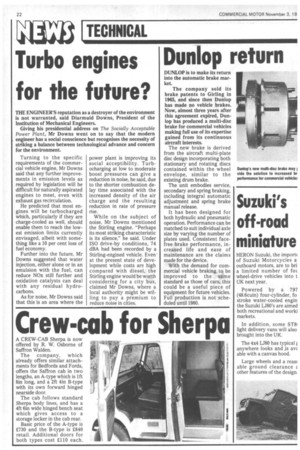Al0 TECHNICAL
Page 24

If you've noticed an error in this article please click here to report it so we can fix it.
Turbo engines for the future?
THE ENGINEER'S reputation as a destroyer of the environment is not warranted, said Diarmuid Downs, President of the Institution of Mechanical Engineers.
Giving his presidential address on The Socially Acceptable Power Plant, Mr Downs went on to say that the modern engineer has a social conscience but recognises the necessity of striking a balance between technological advance and concern for the environment.
Turning to the specific requirements of the commercial vehicle engine, Mr Downs said that any further improvements in emission levels as required by legislation will be difficult for naturally aspirated engines to meet, even with exhaust gas recirculation.
He predicted that most engines will be turbocharged which, particularly if they are charge-cooled as well, should enable them to reach the lowest emission limits currently envisaged, albeit with something like a 10 per cent loss of fuel economy.
Further into the future, Mr Downs suggested that water injection, either alone or in an emulsion with the fuel, can reduce NOx still further and oxidation catalysts can deal with any residual hydrocarbons.
As for noise, Mr Downs said that this is an area where the power plant is improving its social acceptibility. Turb°charging at low to moderate boost pressures can give a reduction in noise, he said, due to the shorter combustion delay time associated with the increased density of the air charge and the resulting reduction in rate of pressure rise.
While on the subject of noise, Mr Downs mentioned the Stirling engine. "Perhaps its most striking characteristic is its silence," he said. Under ISO drive-by conditions, 74 dBA had been recorded by a Stirling-engined vehicle. Even' at the present state of development while costs are high compared with diesel, the Stirling engine would be worth considering for a city bus, claimed Mr Downs, where a local authority might be willing to pay a premium to reduce noise in cities.




























































































































